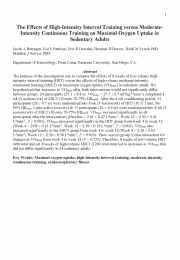- Resource Types
- Resource Languages
- Institutional Repository
 Visit the home page
Visit the home page
About Site Language
WHDL is viewable in multiple languages. Use the pull-down menu to select a language to view the site.
I changed my language, but I’m still seeing resources in the other languages?
If a resource or text has not been translated into your selected language, it will appear in the initially added language. We are always looking for help translating these resources. If you can help, contact us!
WHDL - 00011700


The purpose of the investigation was to compare the effects of 8 weeks of low-volume high-intensity interval training (HIIT) versus the effects of high-volume moderate-intensity continuous training (MICT) on maximum oxygen uptake (VO2max) in sedentary adults. We hypothesized that increases in VO2max after both interventions would not significantly differ between groups. 24 participants (27.1 ± 8.4 yr, VO2max = 27.7 ± 6.7 ml*kg-1*min-1) completed 4 wk (3 sessions/wk) of MICT (30 min, 70-75% HRmax). After the 4 wk conditioning period, 13 participants (28 ± 9.7 yr) were randomized into 8 wk (3 session/wk) of HIIT (10 X 1 min, 90-95% HRmax, 1-min active recovery) & 11 participants (26 ± 6.9 yr) were randomized into 8 wk (5 sessions/wk) of MICT (30 min, 70-75% HRmax). VO2max increased significantly in all participants after the interventions (Baseline = 2.01 ± 0.47 L*min-1, Week 12 = 2.30 ± 0.41 L*min-1, P < 0.001). VO2max increased significantly in the HIIT group from week 4 to week 12 (Week 4 = 2.08 ± 0.21 L*min-1, Week 12 = 2.29 ± 0.19 L*min-1, P < 0.001). VO2max also increased significantly in the MICT group from week 4 to week 12 (Week 4 = 2.18 ± 0.63 L*min-1, Week 12 = 2.30 ± 0.58 L*min-1, P = 0.010). There was no group X time interaction for changes in VO2max from week 4 to week 12 (P = 0.755). Therefore, 8 weeks of low-volume HIIT (480 total min) & 8 weeks of high-volume MICT (1200 total min) led to increases in VO2max that did not differ significantly in 24 sedentary adults.
Arete: The PLNU Honors Journal
81 Resources